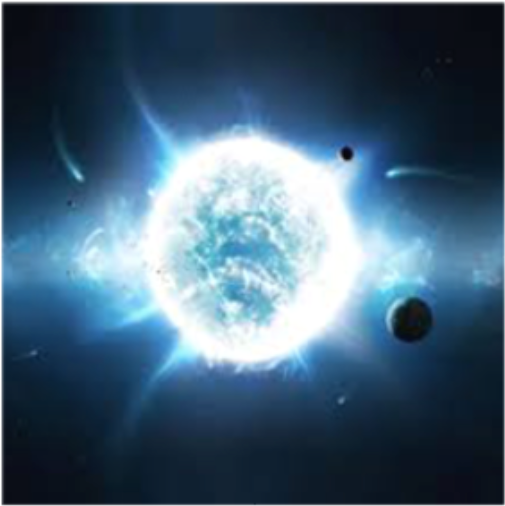Neutron Star Discovered close to Earth
- Alys Wilde and Finja Heumueller
- Jan 27, 2023
- 5 min read
THERE WILL BE NO ESCAPE: Neutron Stars inch ever closer to reaching our Solar System
What if a neutron star were to enter our solar system? We would like to provide a simple yet somewhat complicated answer to that question. However, if one thing remains certain, it’s that there will be no escape from the devastation and chaos to take place within our solar system.

Catastrophe Strikes
Following the arrival of this stellar object, each and every object resigning within the Solar System would be greatly affected by gravitational disruptions, causing disorder between planets as they fall out of orbit. In contrast, comets and asteroids drifting along the asteroid and kuiper belts would be destabilized.
Provided that Earth would be flung far away from the sun, devastating our planet and others alike by diminishing their orbits. The planet humankind would once have called home would no longer be habitable, due to dropping temperatures and lack of heat. Without the presence of sunlight, the world would obtain an icy crust, driving the planet to resemble a snowball. The probability that this would drive the entire planet beyond the livable point remains quite high. In short, to accompany the loss of our sun, devastation of humanity would follow, and Earth would find itself to be endlessly roaming the borders of the universe as a rouge planet in absolute solitude.
Should we be Afraid?
What could this 12 mile large monster really have the potential to do? The truth is, it isn’t one. This might sound like a colossal stellar object hurdling through space, and in that case, you would be somewhat incorrect. On our scale, a neutron star is indeed a giant, but only close to the size of Manhattan Island, which compared to the sun, is not very much. Should we be afraid of them spinning toward us?
Not quite yet.
Fortunately for us, the closest known neutron star to our solar system is approximately 500 light-years away, making it very unlikely for anything like this to occur. On the downside, decreasing distances from our home planet are shown by a number of neutron stars. However, this all depends on the course the neutron star takes. As of the present, astronomers have already found a way to avert asteroid collisions by changing their courses and are currently taking initiative. Hence, if asteroids within the kuiper belt and other space debris were to be sent our way by a passing neutron star, our chances of avoiding a catastrophe might increase over the coming decades.
The Monster Within
What exactly are neutron stars? Amidst the vast and limitless world of astronomy, neutron stars are considered the densest object astronomers can observe directly, their surface so dense that it holds the ability to warp spacetime itself. The name “neutron star” is derived from the fact that they consist primarily of neutrons, while widely resembling huge atomic nuclei. Though only measuring to approximately 20 kilometers in diameter, neutron stars take their place alongside planets, being that they possess a liquid core and crust similar to earth’s.
Even so, their mere presence is due to the death of something remarkable. Of that of something extraordinary. Stars. Due to a fragile balance, these celestial leaders can find themselves on the brink of collapse, as two opposing forces seek to tear it apart. Alike most matter in the universe, stars are neither solid, liquid or gas, but brimming with millions of billions of trillions of tons of hot plasma. As gravity pulls this mass inwards, material pressed against one another so forcefully that nuclei fuse hydrogen into helium, and these stars may find that one of these forces have gained control.
Protons and electrons, two freely flowing particles within this plasma, would prefer to keep their distance from one another. Thus, once in close proximity, protons and electrons combine, forming tightly packed neutrons, or atomic nuclei. Under the intense pressure of the exploding star, these chemical reactions occur, causing a sphere of pure nuclear matter to be confined within an iron ball the size of planet Earth. This iron ball resigns within the star, and with it, the wake of an interstellar explosion.
To accompany the core, the entire star collapses, as gravity draws in its surface at a velocity of 100 million miles per hour, equivalent to 25% the speed of light. The iron core is hit by the implosion, which causes a shock wave to be created that expands outward and launches the rest of the star into space. This explosion, referred to as a supernova, will be brighter than whole galaxies. A neutron star is currently all that's left of the star. Though compacted to an object of roughly 25 kilometers, the neutron star has a mass nearly a million times that of the Earth. In comparison, it’s around a billion tons of space matter confined within a popular tea addition, a sugar cube. Apart from black holes, this stellar objects possesses one of the strongest gravitational fields, and provided it were much denser, it would morph into one.
Companionship and Neutron Stars
Companionship in the vastest place known to mankind is unlikely, but remains possible. However, while companionship is one thing, neutron stars are another. Alike ordinary stars, these ones can be found distributed across any region of space, either in solitude or alongside a friend. Once a companionship is made, a collision is almost certain to follow, making interstellar friendship a perilous task. In what seems to resemble a skip dance motion, both neutron stars begin their celestial dance, spiraling inwards and spinning rapidly towards one another.
In an instant, they make contact. A kill-nova explosion takes place, demolishing both stars in the process, while dispersing stellar material in every direction. Their orbits can erode by dissipating energy in the form of gravitational waves, many of which can create disturbances in spacetime. As a result, two neutron stars have now undergone a second death by collapsing into a black hole. Stars not only have to fall once, but twice, in order to produce some of the most important materials in the known universe. Being incredible and scary, it might be safe to say that this process is among the extraordinary, and finished.
Though neutron stars are just giant atomic nuclei, they are also some of the most extreme things that astronomers continue to study today. As of the present, these space scientists have explored numerous possible outcomes of a neutron star entering the solar system. If they know one thing for certain, it is that occurrences like this one will not take place for a long time, considering that even the closest star will not pass by earth for the next 300,00 years, still not close enough to do significant damage. Thus, we can look forward to spending the same amount of time living our lives to the fullest. Nonetheless, this astronomical journey is light-years away from ending, for astronomers continue to venture the depths of space, and new discoveries are yet to be found, just like this one.
For more information, go to:






Comments